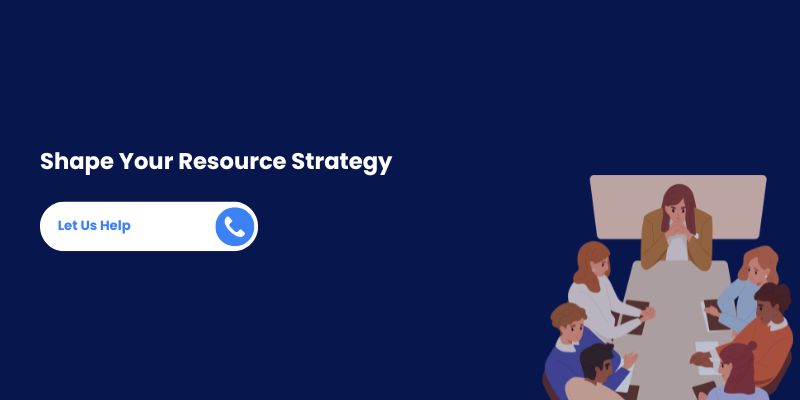Resource augmentation is an important strategy for human resources teams to boost their operational efficiency and fulfill the needs of a dynamic workforce. Find out how it helps HR teams reduce recruitment time and costs and integrate talented staff into existing teams.
According to a report by Manpower Group, 75% of companies find challenges in addressing skill gaps, leading to project delays and reduced efficiency. Resource augmentation services is a reliable solution that helps companies to hire skilled professionals temporarily to fill critical roles while reducing costs related to permanent hiring.
In this blog, we’ll discuss resource augmentation and how it helps HR teams find the right talent for organizational needs and adapt to project demands.
Resource augmentation services refer to including skilled professionals in a company to address skill gaps and fulfill specific business needs. This model allows companies to scale quickly by hiring external experts without committing to long-term commitment. A resource augmentation model is a flexible and economical approach that offers access to specialized talent. The best resource augmentation service examples include hiring staff for IT, project management, and development to fulfill demand while ensuring productivity.
Here are some ways in which resource augmentation helps HR teams.
Regular hiring processes take time—weeks or months. However, resource augmentation contracts offer HR teams access to a pre-vetted talent pool, reducing the time-to-hire to as short as a day and enhancing the speed of hiring external staff to address skill gaps.
Integrating augmented staff into existing teams allows HR professionals to manage projects more effectively. Organizations can have better control over their projects, delegate tasks to augmented resources, and complete projects within specific timelines. While internal teams can focus on core responsibilities, IT staff augmentation services provide augmented staff who can cater to project needs and complete their allotted tasks.
Many costs, such as recruitment expenses, training, benefits, and allowances, are involved in the traditional hiring process. By adopting the resource augmentation models, organizations can cut these costs by hiring professionals and working with them only when needed, thereby eliminating additional costs. This approach is highly beneficial for small organizations and start-ups that have financial constraints.
Resource augmentation allows the HR teams to source talent from different locations, thereby bringing out the best talent. This gives organizations a competitive advantage over others where their teams can work on critical projects and earn clients’ trust.
IT staff augmentation services can be scaled up and down depending on the requirements and projects. Companies can release them when their projects are complete. This approach is highly beneficial in IT industries where project scopes may change rapidly.

HR teams must follow the below-mentioned practices to implement resource augmentation and achieve the best results.
The HR teams must convey the project requirements clearly to the candidates. This includes skills needed, project details and timelines, expected results, budget, and other deliverables. By doing so, the HRs can be sure that they are hiring the right candidates, and candidates also know what is expected from them.
The HR departments should choose a reputable resource augmentation partner to help them hire vetted candidates. By opting for reliable partners who have a good reputation in the industry, they can access a diverse talent pool. It is recommended to check reviews and testimonials to verify the credibility and reliability of the chosen partner.
The HR teams must ensure the augmented staff easily integrates within the team. They must manage the staff actively and help them understand company culture, processes, and expectations. Also, they must perform regular check-ins to ensure everything is aligned, streamlines communication and collaboration within the internal teams and augmented staff.
The HR teams must define key metrics that will help them evaluate the performance of the augmented staff against the project goals. This will enable them to identify areas for improvement and ensure both the internal teams and external staff are working towards common goals.
Once HR teams have onboarded the augmented staff, it is important to offer continuous support. This helps them to understand their queries, provide relevant resources, and guide them to ensure the augmented staff feels valued and motivated to work.
Though resource augmentation offers many benefits, it also comes up with various challenges that the HRs must overcome for successful implementation. Some of the common challenges include:
Cultural differences may bring significant challenges to them. Due to diverse geographical and cultural backgrounds, there could be differences in work ethics, working styles, and business practices. At times, these cultural differences may lead to misunderstandings and conflicts within teams and impact project outcomes.
To overcome this challenge, HR must set clear communication guidelines and conduct training sessions for internal and external teams to help them understand each other’s work culture and ethics.
Differences in time zones and communication styles may bring some hindrance in effective communication. For example, teams working across different time zones may find it difficult to coordinate meetings and respond promptly to emails/messages, leading to delays in project timelines.
Therefore, it is advised to ensure clear communication within teams, allowing for real-time updates and feedback. Also, the HRs must encourage open feedback where the team members can share their opinions and suggest ways to improve how teams interact.
Maintaining quality control is challenging when working with augmented teams. The external staff must abide by the organization’s rules and procedures and fulfill work standards and expectations. Poor quality control may lead to inconsistent work delivery, client dissatisfaction, and even damage the organization’s reputation.
The HR teams must specify quality standards, conduct performance reviews, and provide feedback to ensure the external staff aligns with the organizational goals.
Both resource augmentation and outsourcing involve hiring external professionals. However, they are different. The table below draws a quick comparison between the two.
| Aspect | Resource Augmentation | Outsourcing |
| Control | HR has strict control over the tasks and processes. | The outsourcing vendor has control over projects and tasks. |
| Flexibility | Flexible staffing levels | Long-term contracts. |
| Integration | Augmented staff works with internal teams. | Teams work independently |
| Project scope | Suited for tasks that need in-house collaboration. | Ideal for large-scale projects |
| Cost | Pay-as-you-go | Economical for long-term needs. |
As remote work is increasing, resource augmentation will play a significant role in workforce management. The demand for specialized skills is rising and will continue to do so, making resource augmentation a valuable tool for HR teams who want to create a flexible, efficient, and scalable workforce.
By implementing resource augmentation, organizations can achieve their goals and objectives by completing projects and striving toward growth. Further, the ability to scale the workforce up and down helps them address skill gaps when needed to fulfill business demands while reducing costs.

Resource augmentation services play an important role in enhancing an organization’s efficiency and productivity. By hiring external staff and bringing in relevant resources, companies can scale their operations and cope with changing market demands.
With resource augmentation, organizations get access to specialized talent who can work with existing teams and bring in relevant expertise to complete specific projects and support business operations. Whether you need short-term or long-term support, resource augmentation allows companies to expand their team and accomplish critical milestones.
Here are a few more helpful links for you.
Resource augmentation transforms how HR teams work, giving them a strategic advantage in today’s competitive business world. By using this model, organizations can address skill gaps, improve project management, and increase flexibility in the workforce. The HR teams can focus on their core responsibilities while ensuring the organizations can access the right talent.
An example of resource augmentation can be an IT company that might be looking to augment its resources by hiring more staff or investing in new technology to increase efficiency and productivity.
Resource augmentation allows businesses to quickly bring in external professionals to fill skill or capacity gaps without the long lead time of full-time hiring. Whether it’s an HR transformation project or expanding a tech team, this model gives you instant access to vetted talent. At DataToBiz, we help organizations match the right expertise to the right role so nothing slows down your operations.
With resource augmentation, you stay in control. The added professionals work directly with your internal team, aligned to your tools, culture, and goals. Traditional outsourcing often hands over full control to an external team. Resource augmentation gives you flexibility and strategic oversight without the long-term commitment of hiring.
HR leaders play a key role in building agile, scalable teams. By using strategic staffing models like resource augmentation, they can support evolving business needs without overcommitting budgets. This includes adding specialists for short-term projects, peak periods, or while permanent hiring is underway. It’s about flexibility with impact.
While it’s often used for short- to mid-term needs, resource augmentation can also support long-term initiatives. Many organizations use it to maintain continuity during hiring freezes, experiment with new roles before formalizing them, or support hybrid workforce models. At DataToBiz, we provide flexible engagement models that adapt to both short-term execution and long-term planning.
Cultural fit matters just as much as technical skills. A proper onboarding process, regular check-ins, and clearly defined expectations are key. We also recommend working with partners who vet talent not just for capability, but for communication, collaboration, and values alignment. That’s something we prioritize at DataToBiz when recommending professionals to our clients.
Absolutely. In fact, it’s one of the fastest ways to scale up specialized skills for strategic initiatives like digital transformation, AI implementation, or data analytics projects. By augmenting your team with consultants or engineers who have done it before, you reduce learning curves and execution risk.
Fact checked by –
Akansha Rani ~ Content Creator & Copy Writer
